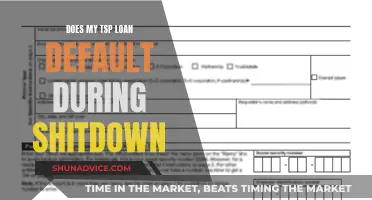
Homeowner's insurance is a type of property insurance that covers damage to a home caused by certain perils, including fire, lightning, hail, and explosions. It also covers personal belongings within the home, such as furniture, clothing, and electronics. While it is not legally required, homeowners insurance is often mandated by lenders as a prerequisite for mortgage approval. The amount of coverage required by lenders is typically based on the replacement cost of the home, ensuring that the loan is covered in the event of a total loss. In some cases, the minimum insurance requirement may only need to cover the remaining loan balance. However, it is recommended to have sufficient coverage to protect against financial loss and ensure peace of mind.
| Characteristics | Values |
|---|---|
| Homeowner's insurance required for a loan? | Yes, lenders require homeowners insurance so that the property they have an investment in is fully covered against catastrophic damage. |
| Who does it protect? | The homeowner, by paying for damage resulting from a covered claim, and the lender, by protecting their investment in the home. |
| What does it cover? | Fire, lightning, hail, wind, storms, explosions, vandalism, and other covered perils. |
| What does it not cover? | Intentional damage or illegal activity that causes damage or bodily harm done by the named insured. |
| How much coverage is needed? | Enough to cover the replacement cost of the structure, which may be more or less than the loan amount or the market value of the home. |
| How is the required coverage amount determined? | Calculation of the replacement cost of the structure, which may be detailed in the loan agreement. |
| Can the lender buy insurance on the borrower's behalf? | Yes, if the borrower does not keep up their homeowner's insurance, but this insurance may only cover the lender and be more expensive. |
What You'll Learn

Lender requirements
Lenders will also require you to have liability insurance, which protects you if you are sued or someone is injured on your property. Since your home is likely your most valuable asset, a plaintiff may go after it in a lawsuit. Your mortgage company has a stake in that asset, which is why they require at least a minimum level of liability coverage, which typically starts at $100,000.
The amount of homeowners insurance required by lenders typically equals at least the amount of the mortgage loan or the replacement cost of the house, whichever is higher. The aim is to cover the cost of rebuilding the house in the event of a total loss. This can vary based on factors like the home's location and susceptibility to certain hazards. Most lenders require that you insure your home up to its replacement cost, and your policy will need to cover hazards like fire, wind, hail, and vandalism.
In addition to standard homeowners' insurance, lenders may also require you to purchase additional coverage depending on the location of your home. For example, if you live in an area prone to flooding or earthquakes, your lender may mandate that you purchase flood or earthquake insurance.
Finally, it's important to note that lenders may require you to pay for homeowners insurance in advance to safeguard their investment. This can be beneficial as many insurance providers offer a discount for prepaying your insurance. However, it's a good idea to regularly review your policy and shop around to ensure you're getting the best coverage at the best price.
Retirement Savings: Mutual of America's Loan Policy Explained
You may want to see also

Homeowner policy exclusions
Homeowner insurance is designed to protect your finances against sudden and accidental damage, like storm damage or someone hurting themselves on your property. However, there are several exclusions to what homeowner insurance covers. Firstly, it is important to note that the exclusions in your insurance policy depend on your insurance company, your location, and your specific situation. While some companies may include typically excluded coverages, others may have exclusions that are rare in the industry.
One of the most common exclusions in homeowner insurance policies is flood damage. Standard policies typically do not cover floods, including those caused by sewer backup, sump failure, or water seeping into your home's foundation. Similarly, water damage caused by backed-up sewer lines or overflowing sump pumps is often excluded. However, a standard policy usually covers burst pipes and the resulting water damage. Additionally, some policies may offer limited coverage for mold remediation if it is a result of a covered instance, like water damage from a burst pipe or fire.
Another common exclusion is pest infestations, including insects and rodents. Homeowner insurance typically does not cover the costs of eradicating and remediating infestations. However, if pests cause a covered loss, such as an electric fire from chewed wiring, the resulting damage may be covered.
Earthquakes, landslides, mine subsidence, and mudflows are also typically excluded from standard homeowner insurance policies. If you live in an area prone to these events, you may need separate coverage.
It is worth noting that some insurance companies may refuse coverage or charge higher rates if you own certain breeds of dogs that are known for aggression or have a history of inflicting severe injuries.
To ensure you are adequately protected, carefully review your policy's exclusions and consider purchasing endorsements or add-ons to fill any coverage gaps.
Budgeting for Loans: Strategies for Financial Success
You may want to see also

Loan amount vs insured amount
When it comes to homeowner's insurance, lenders require you to have a policy in place before funding your loan. The amount of insurance coverage required by the lender is based on the replacement cost of your home and you must maintain this policy until your mortgage is paid off. This is to protect the lender's investment in your home.
The loan amount you borrow and agree to repay the lender may include loan fees, points, and sometimes even closing costs. This can differ significantly from the insured amount, which is the amount of insurance coverage you have as stated in your policy. In the event of a claim, you may face a situation where the insured amount is less than the loan amount. For instance, if you owe your lender a total of $20,000, your automobile insurance coverage may only cover the cash value of your vehicle, which could be $15,000. In this case, you would still need to repay the full $20,000 on your loan.
To ensure full protection of the loan amount, you may need to purchase additional insurance. In the case of auto insurance, gap insurance can be purchased to cover the difference between the amount owed and the insured amount. Similarly, for homeowner's insurance, you may benefit from securing insurance that covers the full loan amount, depending on your financial situation. This will protect you, the borrower, and the lender from financial loss in the event of a claim.
It is important to note that the price you paid for your home may not reflect the cost of rebuilding it. Construction costs can vary due to factors such as location, type of construction, and style of the house. Additionally, in the event of a disaster, the cost of rebuilding may increase due to higher demand for building materials and labour. Therefore, it is recommended to have enough homeowners insurance to cover the cost of rebuilding your home, replacing your belongings, and defraying additional living expenses if needed.
To determine the right amount of insurance coverage, it is advisable to consult with an insurance agent who can help you choose a policy that meets your unique needs.
Multiple Buyers: Boon or Bane for Loans?
You may want to see also

Mortgage insurance vs. homeowners insurance
When buying a home, you may be required to carry both mortgage insurance and homeowners insurance. However, despite sounding similar, these two types of insurance are very different.
Mortgage Insurance
Mortgage insurance, also known as private mortgage insurance (PMI), financially protects the lender in case the homeowner defaults on their mortgage payments. It is required for borrowers who make a down payment of less than 20% when purchasing a home. With PMI, the homeowner pays a percentage of their total mortgage cost each year, and if they are unable to make mortgage payments, the insurance company will pay the lender on their behalf.
Homeowners Insurance
Homeowners insurance, also known as hazard insurance, financially protects the homeowner's investment by providing coverage for the structure, contents, and liability, among other coverage types. It helps repair or rebuild the structure of the home and property in the event of damage or loss caused by unforeseen events, such as fires, storms, or other covered perils. It also protects the lender's investment by ensuring that the asset (the home) isn't a complete loss in the event of damage or destruction. Most policies also cover detached structures on the property, such as a storage shed or gazebo. Additionally, homeowners insurance shields the homeowner from lawsuits if someone gets hurt on their property.
Loan Price and Insurance Coverage
It is important to note that the loan amount and the insured amount can differ significantly. While your loan amount may be $200,000, your home insurance may only cover the cash value or replacement value of your home and belongings, which may not equal your loan amount. In the event of a claim, you would still be responsible for the full repayment of your loan. Therefore, it is recommended to consider securing insurance that covers your full loan amount to protect against financial loss.
Mshda's 203(k) Loan Permission: A Guide to Renovation Loans
You may want to see also

Inflation guard clauses
Homeowner's insurance is required for as long as you have a loan. The amount of insurance coverage you have is stated in your policy. This amount can differ significantly from the loan amount. For instance, while you might have a mortgage loan for $200,000, your home insurance may only cover the cash value or replacement value for your home.
The primary purpose of an inflation guard is to ensure that your dwelling coverage limit is sufficient to cover the rising costs of building materials and labour in your area. Dwelling coverage pertains to the structure of your home itself, and in some cases, it can also apply to other structures on your property, like a detached garage. Depending on your policy, an inflation guard may also apply to personal property coverage.
The inclusion of an inflation guard in your policy means that your coverage amount will be automatically adjusted at each renewal to keep up with rising costs. This adjustment is based on predictions from vendors such as CoreLogic. For example, if your home is insured for $200,000 and your policy has a 4% inflation guard rate, your coverage limit might increase to $208,000 the next year.
It is important to note that while inflation guard coverage is usually built into standard homeowners insurance, there may be cases where you need to add it as a separate endorsement to your policy. Experts recommend purchasing inflation guard protection if you plan on owning your home for an extended period, as prices can increase year after year.
Mudra Loan Subsidy: What Borrowers Need to Know
You may want to see also
Frequently asked questions
Yes, homeowner's insurance is required for as long as you have a loan. It is also sometimes referred to as "hazard insurance".
The amount of insurance you need depends on the replacement cost of the structure. Lenders require you to have enough insurance to replace your home, which may include mortgage insurance. You will need to keep a homeowner's insurance policy in force until you have paid off your mortgage.
Homeowner's insurance covers damage that's caused by fire, hail, lightning, vandalism, and other covered perils. It also covers personal property, loss of use, and liability.







